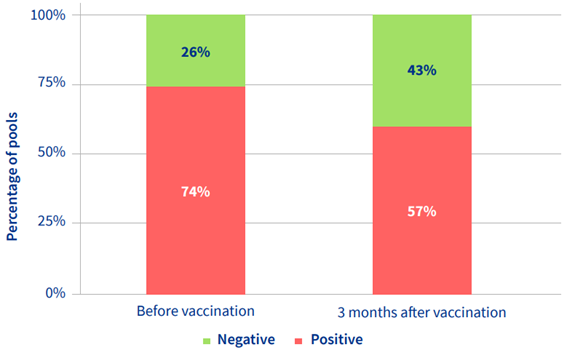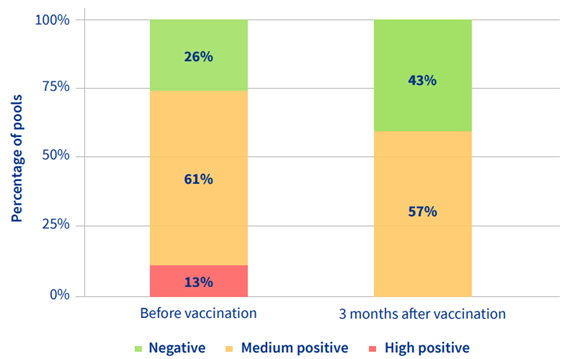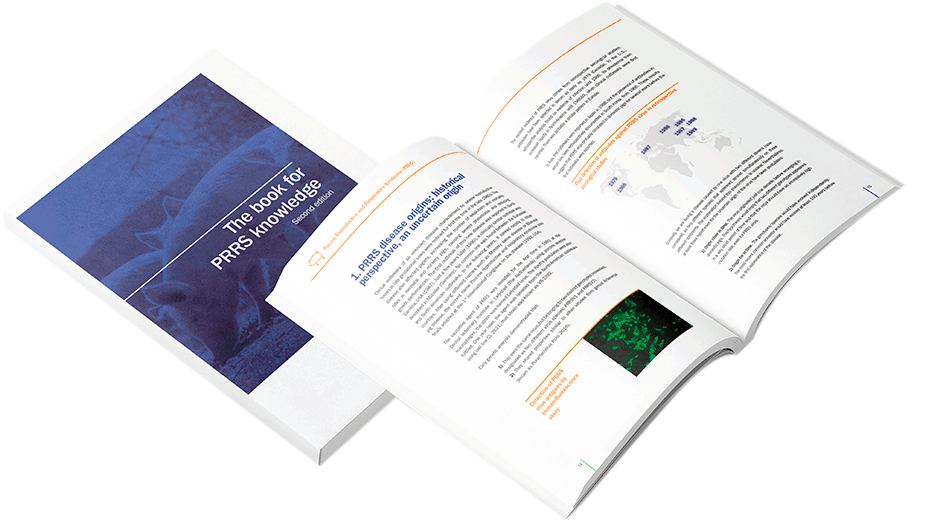Publication of Lidia de Lucas et al. in the ESPHM 2022.
Field evaluation of infection pressure reduction in nurseries when vaccinating piglets against PRRS in European infected farms
Introduction
PRRS is still the costliest disease for the global swine industry. Piglet vaccination against PRRS, has stopped being an infrequent practice, to become a common tool for controlling disease. A successful piglet vaccination strategy, adjusted to the specific needs of each farm, has proven to be a useful tool to reduce the proportion of infected animals, the duration of viremia and viral excretion, thus reducing the infection pressure in an infected farm1.
The objective of this trial was to demonstrate the infection PRRS virus pressure reduction in nurseries owing to a PRRS MLV vaccine applied to piglets in endemically infected farms.
Materials and Methods
The study was performed on 7 European farms during 2019-2020. All farms with the nursery unit present in the same location as the sow herd, were PRRS positive. Among different measures to reinforce disease stability, a piglet vaccination program against PRRS was implemented. Piglets were intradermally vaccinated at 2-3 weeks of age with UNISTRAIN® PRRS (PRRS live vaccine of HIPRA, 0.2 ml/dose).
On each farm, the piglets were sampled at two different time points at the end of the nursery phase: before vaccination started (n=30) and 3 months after vaccination started (n=30). Serum samples were tested in 5 samples/pool by ORF7 RT-qPCR for PRRSV detection and ORF7 sequencing for PRRSV characterization was performed from PCR positive samples (Ct values below 37). A total number of 110 pools were analyzed, 61 before vaccination and 49, 3 months after vaccination started.
Results
Considering all the farms´ results, a decrease of positivity in the pools was detected, from a rate of 74% before vaccination started to 57% 3 months after vaccination started (Fig 1).

Figure 1. Evolution of PRRS positivity, expressed in positivity of pools in the nursery phase during the study.
In addition, positivity was studied at two different levels: “medium positive” referred to samples with Ct values between 36 and 26 and “high positive” referred to samples with Ct values below 25. Differences in high positive results were found between samplings before vaccination started (13%) and 3 months after vaccination started (0%) (p-value 0.02) (Fig 2).

Figure 2. Distribution of negative, medium positive and high positive PCR results in the nursery phase before vaccination and 3 months after piglet vaccination started.
Discussion and Conclusion
Reduction of the PRRSv circulation and so lower probability of infection was demonstrated in nurseries vaccinated with UNISTRAIN® PRRS. However, as virus circulation is still present 3 months after vaccination, these results illustrate that a vaccination program in piglets against PRRS should be implemented for a longer period to eliminate virus circulation in infected nurseries.
Overall, PRRS piglet vaccination is a means of reducing PRRS infection pressure and can avoid costly economic losses associated with the disease.
If you want to read more publications about PRRS: PRRS Control Publications
You can ask your own question! Visit Pig333.com and submit your question to the experts.
References
- Miranda, J. et al. 2015. Vaccination with UNISTRAIN®PRRS in piglets reduces viraemia and excretion of PRRSv after a heterologous challenge with a Spanish strain. Proceedings of International PRRS Congress, Ghent, Belgium – June 3-5, 2015, p.48.
HIPRA © All rights reserved



